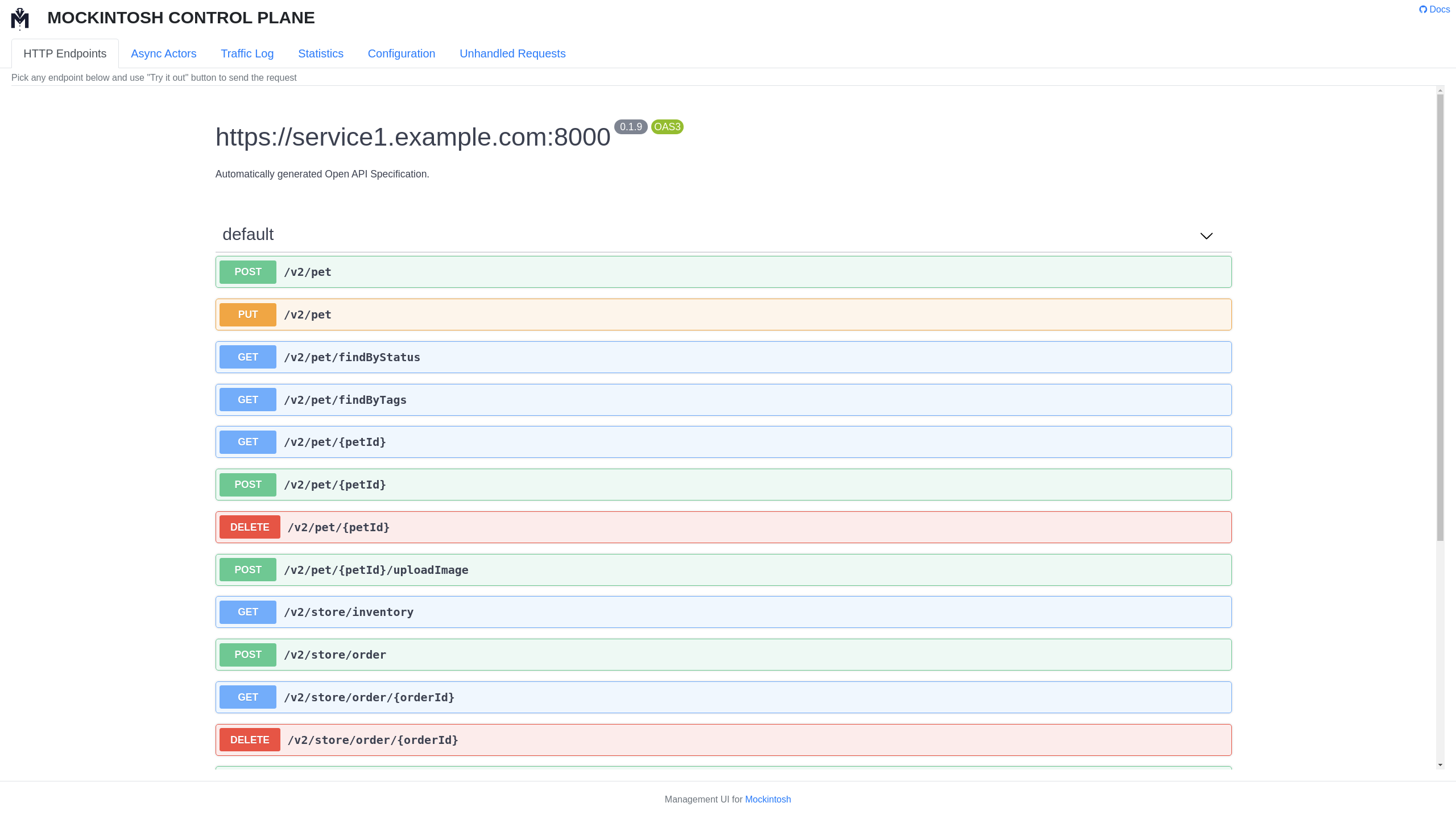The API mocking server for microservice environments
Project description
Mockintosh
You've just found a new way of mocking microservices!
An example config that demonstrates the common features of Mockintosh:
templatingEngine: Jinja2
services:
- name: Mock for Service1
hostname: localhost
port: 8001
managementRoot: __admin
endpoints:
- path: "/"
method: GET
response:
headers:
Content-Type: "text/html; charset=UTF-8"
body: "@templates/index.html.j2"
- path: "/users"
method: GET
response:
headers:
Content-Type: "application/json; charset=UTF-8"
body: "@templates/users.json.j2"
- name: Mock for Service2
hostname: service2.example.com
port: 8002
endpoints:
- path: "/companies"
method: POST
body:
schema:
type: object
properties:
name:
type: string
address:
type: string
required:
- name
- address
response:
headers:
Content-Type: "application/json; charset=UTF-8"
body: "@templates/company.json.j2"
Mockintosh is a service virtualization tool that's capable to generate mocks for RESTful APIs and communicate with message queues to either mimic asynchronous tasks or to simulate microservice architectures in a blink of an eye.
The state-of-the-art mocking capabilities of Mockintosh enables software development teams to work independently while building and maintaining a complicated microservice architecture.
Key features:
- Multiple services mocked by a single instance of Mockintosh
- Lenient configuration syntax
- Request scenarios support with multi-response endpoints
- Performance testing supported (with datasets and low resource footprint)
- Interceptors support for unlimited customization
- Remote management UI+API
In this article we explain how and why Mockintosh has born as a new way of mocking microservices.
Quick Start
Install Mockintosh Python package using pip:
$ pip install mockintosh
Once the installation complete, you can start Mockintosh with a JSON/YAML configuration as an argument, e.g. example.yaml:
$ mockintosh example.yaml
and you should be seeing a web page like this whenever you visit localhost:8001:
Alternatively, you can run Mockintosh as Docker container:
$ docker run -it -p 8000-8005:8000-8005 -v `pwd`:/tmp up9inc/mockintosh /tmp/config.json
Please note the -p flag used to publish container's ports and -v to mount directory with config into container.
After server starts, you can issue requests against it. For example, curl -v http://localhost:8000/ would
respond hello world. Also, consider opening Management UI in your
browser: http://localhost:8000/__admin. Management UI offers visual tools to see available mock endpoints, traffic log
and many other features.
Command-line Arguments
The list of command-line arguments can be seen by running mockintosh --help.
If you don't want to listen all of the services in a configuration file then you can specify a list of service
names (name is a string attribute you can set per service):
$ mockintosh example.yaml 'Mock for Service1' 'Mock for Service2'
Using --quiet and --verbose options the logging level can be changed.
Using --bind option the bind address for the mock server can be specified, e.g. mockintosh --bind 0.0.0.0
Using --enable-tags option the tags in the configuration file can be
enabled in startup time, e.g. mockintosh --enable-tags first,second
OpenAPI Specification to Mockintosh Config Conversion (experimental)
Note: This feature is experimental. One-to-one transpilation of OAS documents is not guaranteed.
It could be a good kickstart if you have already an OpenAPI Specification for your API. Mockintosh is able to transpile an OpenAPI Specification to its own config format in two different ways:
CLI Option --convert
Using the --convert one can convert an OpenAPI Specification to Mockintosh config.
JSON output example:
$ wget https://petstore.swagger.io/v2/swagger.json
$ mockintosh swagger.json -c new_config.json json
YAML example:
$ mockintosh swagger.json -c new_config.yaml yaml
Automatic Conversion
If you start Mockintosh with a valid OpenAPI Specification file then it automatically detects that the input is an OpenAPI Specification file:
$ mockintosh swagger.json
and automatically starts itself from that file. Without producing any new files. So you can start to edit this file through the management UI without even restarting Mockintosh.
Interceptors
One can also specify a list of interceptors to be called in <package>.<module>.<function> format using
the --interceptor option. The interceptor function get a mockintosh.Request and
a mockintosh.Response instance. Here is an example interceptor that for every requests to a path
starts with /admin, sets the reponse status code to 403:
import re
from mockintosh import Request, Response
def forbid_admin(req: Request, resp: Response):
if re.search(r'^\/admin.*$', req.path):
resp.status = 403
and you would specify such interceptor with a command like below:
$ mockintosh some_config.json --interceptor=mypackage.mymodule.forbid_admin
Instead of specifying a package name, you can alternatively set the PYTHONPATH environment variable to a directory
that contains your interceptor modules like this:
$ PYTHONPATH=/some/dir mockintosh some_config.json --interceptor=mymodule.forbid_admin
Note: With interceptors, you can even omit endpoints section from the service config. You will still get all requests
to the service into your interceptor.
Request Object
The Request object is exactly the same object defined in here
with a minor difference: Instead of accesing the dictonary elements using .<key>, you access them using ['<key>']
e.g. request.queryString['a'].
Response Object
The Response object consists of three fields:
resp.statusholds the HTTP status codes e.g.200,201,302,404, etc.resp.headersis a Python dictionary that you access and/or modify the response headers. e.g.resp.headers['Cache-Control'] == 'no-cache'resp.bodyis usually eitherstrorbytes, but can be anything that is supported bytornado.web.RequestHandler.write:str,bytesordicte.g.resp.body = 'hello world'orresp.body = {'hello': 'world'}
Build the Docs
$ gem install jekyll bundler
Install the gems:
$ cd docs/
$ bundle config set --local path 'vendor/bundle'
$ bundle install
Run the server:
$ bundle exec jekyll serve
Useful Links
Project details
Release history Release notifications | RSS feed
Download files
Download the file for your platform. If you're not sure which to choose, learn more about installing packages.


















